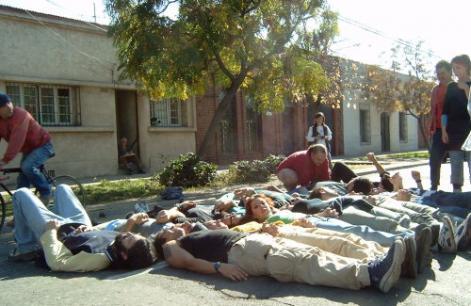Introduction to nonviolence training
Nonviolence training can help participants form a common understanding of the use of nonviolence in campaigns and actions. It is a participatory educational experience, where we can learn new skills and unlearn destructive and oppressive behaviours taught in society. Nonviolence training can strengthen a group, developing a community bond while people learn to work better together. Nonviolence training can help us understand and develop the power of nonviolence. It gives an opportunity to share concerns, fears and feelings, and discuss the role of oppression in our society and our groups. Individually, training helps build self-confidence and clarify our personal interactions as well as those of the group. The goal of nonviolence training is the empowerment of the participant and to be able to engage more effectively in collective action. The process includes the use of various exercises and training methods, some of which are included in this handbook.
Nonviolence training can prepare people for participation in nonviolent direct action, teach people strategy development techniques and the skills needed to engage in the strategy, work on group process and issues of oppression.
Nonviolence trainings are often used to prepare people for specific actions, to learn about the scenario, develop a plan and practice it, understand the legal issues, etc. It is an opportunity for a group to build solidarity with each other and develop affinity groups. Through role playing, people can learn what they might be able to expect from police, officials, other people in the action and themselves. It can help people decide if they are prepared to participate in the action.
Nonviolence trainings can range from several hours to several months. That depends on several factors,including the campaign's needs and timeline, goals for the training, experience and availability of the participants and trainers. See Tasks and Tools for Organising and Facilitating Trainings for more on planning nonviolence trainings.
BOX or Side panel:
“My first training experience was for the 15th of May action in Israel in 2003. I was a Chilean conscientious objector who had been involved in campaigning against militarism for a number of years. The training was truly empowering to me, and I went back home with the urge to share what I had learned and that if we wanted to be successful in our actions, training ourselves was going to be essential. The next actions we did, were not just with all the group standing in front of the military building but with a higher level of risk because of the higher level of confidence we had, because we were prepare and trained for it.” Javier Gárate (full story on the web)
Role of Trainers
A nonviolence trainer is someone who can facilitate a group through a learning process. A trainer needs to be knowledgeable regarding the topics of the training, but should not be a know-it-all. A trainer's goal is to guide the participants to develop their own ideas, not to tell people what to think and do.
We realize that not all groups and communities who want nonviolence training have local trainers. But when people understand what skills are needed to conduct a training, they may realize they have already developed some of those skills, which they have used in different contexts. Create a training team of co-facilitators, who together can bring their skills and experience. The training team should reflect the participants if possible, consisting of women and men, people of various ages, and ethnic background.
Trainers need:
- Good group process skills, with an awareness of group dynamics. It is the role of the trainer to make sure everyone is participating and feeling they can share their insights and experiences.
- An understanding of nonviolent actions and campaigns. If no one has experience, the trainer needs to make sure that case studies and exercises are used to help the group learn.
- To learn how and when to use the right exercises, being sensitive to the needs and styles of groups.
Areas covered in nonviolence training can include:
- History and philosophy of nonviolence and practice of nonviolent action.
- Overcoming oppression, ethnic/racial and gender dynamics.
- Campaign strategy development
- Consensus decision making and quick decision making
- What is an affinity group and the roles within the group
- Skills trainings such as legal and media work.
Contact the WRI Nonviolence Programme to connect with other trainers, and to find out about training for trainers opportunities. There is also a WRI Nonviolence Training Working Group which can be contacted, for requesting trainers for training and also for accessing resources in nonviolence.
A.J. Muste Memorial Institute International Nonviolence Training Fund
This funds makes grants of up to $3,000 for trainings which help people learn how to collectively use the theory and practice of nonviolent action to effectively carry out struggles for social justice. Projects must be located outside the United States, or within Native nations in the US. For grant guidelines and more information, see their website http://www.ajmuste.org or contact the Muste Institute at 339 Lafayette St., New York, NY 10012 info@ajmuste.org.
